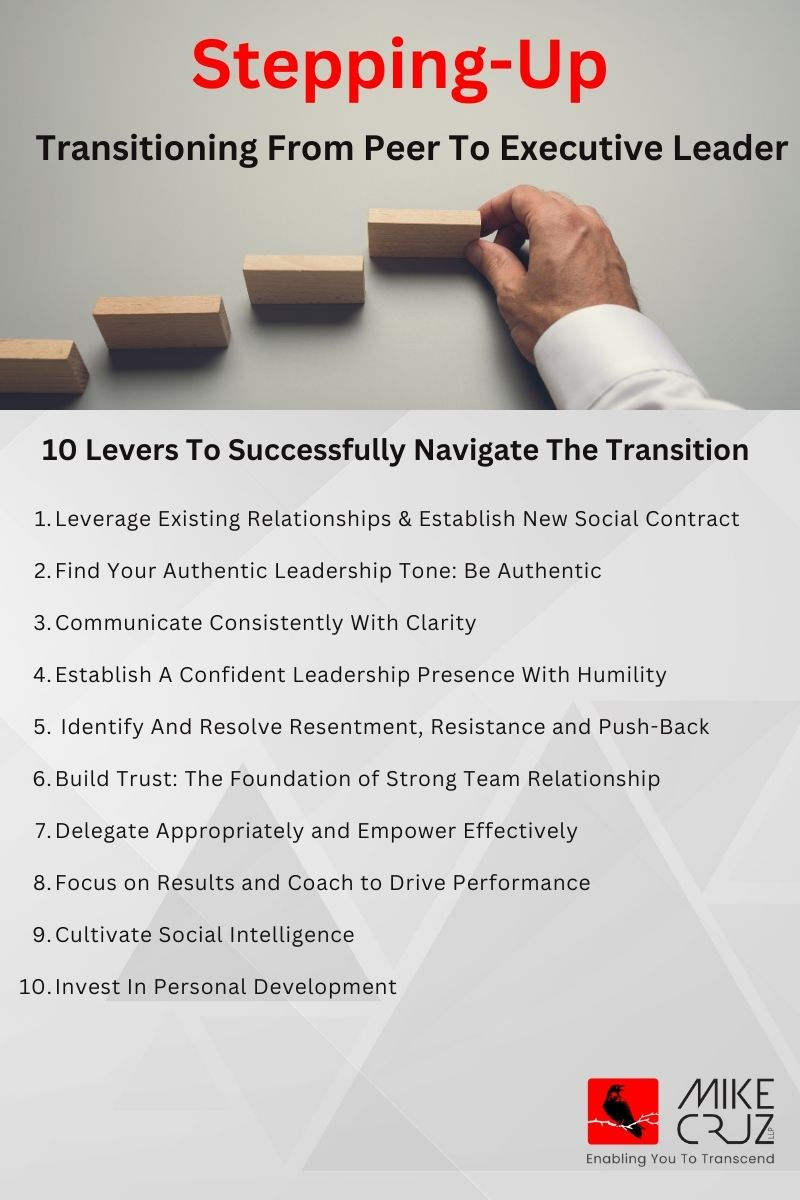Stepping-Up: Transitioning From Peer To An Executive Leader- Guiding Growth Part III of III
- Mike Cruz
- Oct 19, 2023
- 2 min read

This article's first and second parts covered the first seven levers, which helped set the stage for the transition and focus on the team. This final part will focus on guiding growth - for the team, business, and self.
Guiding Growth
8. Focus on Results - Coach to Drive Performance
Why it's important:
A leader's primary responsibility is to achieve results by inspiring and motivating the team to high performance. Adopting a coaching approach that empowers your team in their quest for success while focusing on results is crucial when transitioning from a peer to an executive leader.
What needs to be done:
Set clear objectives: Establish measurable goals and expectations for your team.
Provide guidance and support: Coach and mentor your team members to help them reach their potential and meet their targets.
Offer feedback: Regularly provide constructive, intentional feedback to guide performance improvement.
How it can be done:
Define clear, achievable objectives that align with your team's goals and the organization's mission. Adopt a coaching approach by offering guidance and support rather than micromanaging. Regular feedback/ feedforward sessions help team members understand their progress, identify areas for improvement, and stay motivated to achieve results.
9. Cultivating Social Intelligence: A Key Factor for Success and Future Growth
Why it's important:
Social intelligence, the ability to understand and manage interpersonal relationships, is an invaluable skill for a leader transitioning from a peer to an admired leader. It is pivotal in building strong, collaborative teams and fostering growth.
What needs to be done:
Develop empathy: Understand and relate to the feelings and perspectives of your team members.
Enhance active listening: Pay attention, show that you value your team's input, and acknowledge their concerns.
Improve communication: Tailor your message to your audience, ensuring it's clear and resonates with your team.
How it can be done:
Cultivating social intelligence involves continuous self-awareness and practice. Actively work on understanding your team's needs, being a considerate listener, and adjusting your communication style to connect more effectively. As a leader, your social intelligence will be a crucial factor in your future success and the growth of your team.
10. Invest in Your Personal Development: Set up Your Support System
Leadership is a journey of continuous growth and learning. You must establish a robust support system and invest in your personal development to excel in transitioning from peer to an admired organizational leader and beyond.
What needs to be done:
Seek mentors: Identify experienced leaders who can provide guidance and share their insights.
Engage coaches: Work with leadership coaches to develop and refine your leadership skills.
Establish feedback mechanisms: Create structured systems for gathering objective and intentional feedback to monitor growth.
How it can be done:
Identify potential mentors or coaches who can offer valuable perspectives within and outside your organization. Develop a structured feedback process that includes input from your team, peers, and supervisors. Continually invest in your personal development to stay current and effective as a leader.
Transitioning from a peer to an inspiring, influential, and admired leader is a multi-faceted journey that demands attention to these ten key aspects. Navigating these aspects skillfully ensures a smooth transition and lays a strong foundation for your leadership success.
Embrace the evolving nature of your leadership journey, and continually adapt as you inspire and lead your team to new heights.





Comments